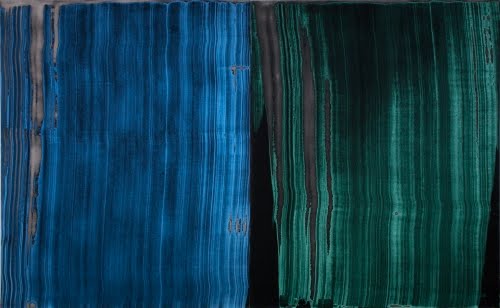An Artist of the "Cool School": Ed Moses
Far too often art history texts sum up the pioneering American avant-garde of the mid-1900s with Abstract Expressionism and the New York scene. Believe it or not, there were avant-garde artists all over the United States by the 1930s, from New York to Chicago to Los Angeles. I get as weary of the New York-focus in so many discussions of American modernism as I do of the Western bias in most art history books.
 |
| Ed Moses (born 1926, United States), Blue Velvet, 2008. Acrylic on canvas, diptych, overall 66" x 108" (167.6 x 274.3 cm). Albright-Knox Art Gallery, Buffalo, NY. © 2017 Ed Moses. (AK-2739) |
Like other “schools” of artists (see “Hudson River,” etc.), the “Cool School” denotes a group of artists in the same art scene. The artists of the Cool School in Los Angeles were instrumental in building recognition of avant-garde art on the West Coast starting after World War II (1939–1945), not of establishing a singular style. In one of the great ironies of art history, the Los Angeles cutting-edge, modernist collection of Walter and Louise Arensberg of the 1940s—a major impetus for the development of an avant-garde scene in LA—is now part of the collection of the Philadelphia Museum of Art.
The art of Ed Moses belongs to this seminal period (and to the present day!) in the development of an institutional art scene in Los Angeles dedicated to the avant-garde. A student of Buddhism, Moses’s paintings have always displayed a certain cool detachment from the strictures enforced by the Abstract Expressionists—their emphasis on star personality and agonizing over personal process.
While Moses’s art is process driven, he avoids the need to control the process in favor of letting abstraction be a transformative experience; in other words, letting the painting go where it wants. A practitioner of daily meditation, Moses has a relaxed way of painting in which—in a Jungian sense—he leaves his body and then lets the paint direct his hand.
There is a lyrical note in paintings like this, where the beauty of pure abstraction is emphasized over the artist’s ego or “signature style.” In addition to free-form abstraction like this, Moses is also noted for his abstract grid works. His early work is quite exciting, and frankly makes the works of Abstract Expressionists such as Barnett Newman pale in comparison. I think this recent work is very nice.
Moses was born in Long Beach, the son of a Portguese father and English/Scottish mother. He studied art at Long Beach City College, University of Oregon, and UCLA before he became aware of Abstract Expressionism, particularly Rothko, de Kooning, and Gorky. While he was in school, he became a technical illustrator in an aircraft factory. That perhaps explains his fascination with grid abstraction from an early point. Having remained in LA most of his life, he has explored a variety of types of abstraction, including hard edge, biomorphic, crackle-like forms, and semi-representational. Rarely using a brush, Moses works in staining, scraping, splashing, and mopping, sometimes achieving lines with tape or snap lines.
Painting professionally since 1949, his first one-person show was at the Ferus Gallery, the very epicenter of the “Cool School.” Moses became one of its stable of Cool School artists, which included Billy Al Bengston (born 1934), Ed Ruscha (born 1937), Ken Price (1935–2012), and Larry Bell (born 1939).


Comments